Business & Environment: Organizational Analysis and Macro Environment
VerifiedAdded on 2020/04/15
|22
|4570
|48
Report
AI Summary
This report provides a comprehensive analysis of the business environment, focusing on different types of organizations, including public, private, and voluntary sectors, along with their respective objectives and legal structures. It examines three specific organizations: Apple Inc. (public), Virgin Atlantic (private), and the British Red Cross (voluntary). The study delves into the scope and size of these organizations, highlighting their interrelated functions and organizational structures. Furthermore, it analyzes the positive and negative influences of the macro environment on business operations, conducting internal and external analyses to identify strengths and weaknesses, particularly for Apple Inc. The report concludes by linking these internal factors with external macro considerations, offering a holistic view of the business environment and its impact on organizational performance. Desklib provides access to similar past papers and solved assignments for students.
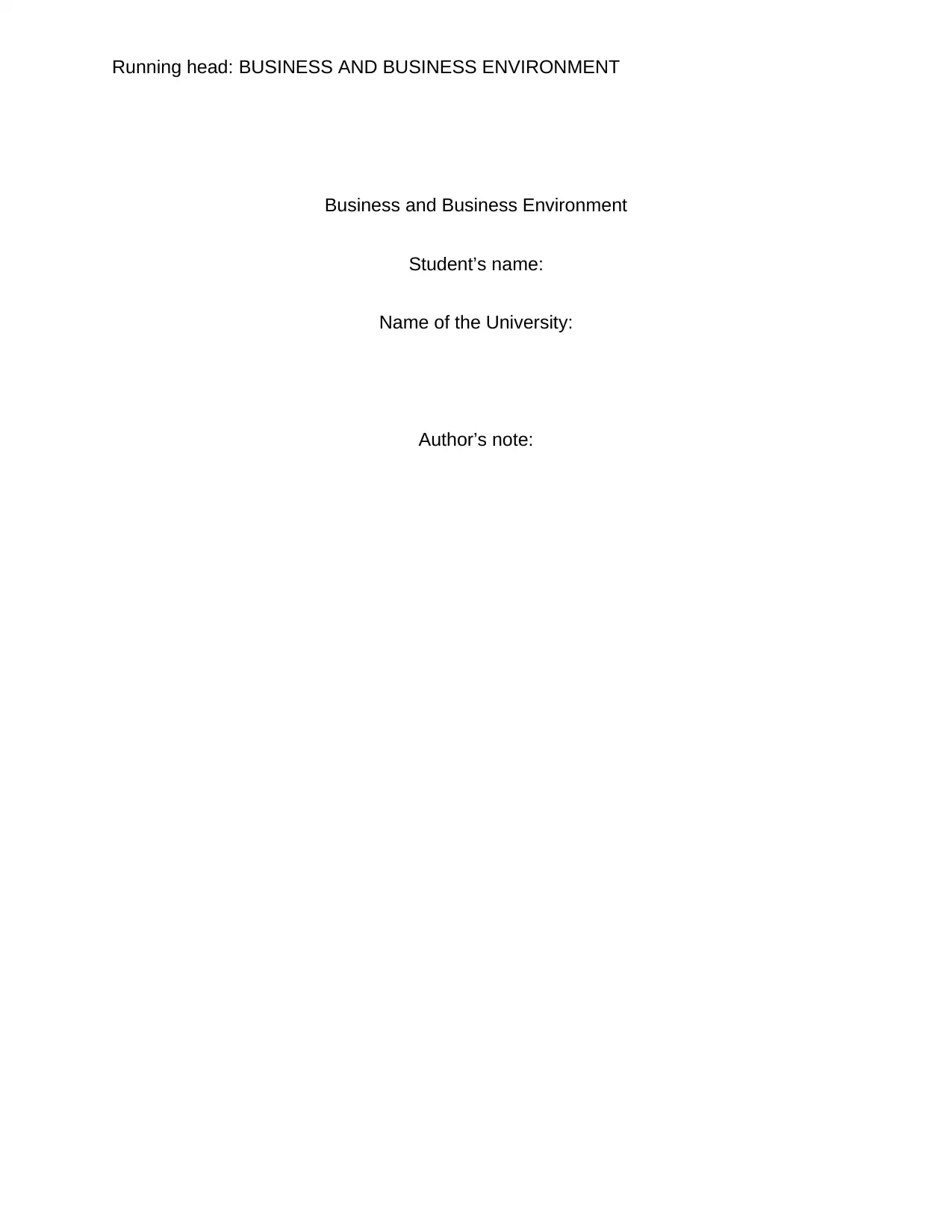
Running head: BUSINESS AND BUSINESS ENVIRONMENT
Business and Business Environment
Student’s name:
Name of the University:
Author’s note:
Business and Business Environment
Student’s name:
Name of the University:
Author’s note:
Paraphrase This Document
Need a fresh take? Get an instant paraphrase of this document with our AI Paraphraser
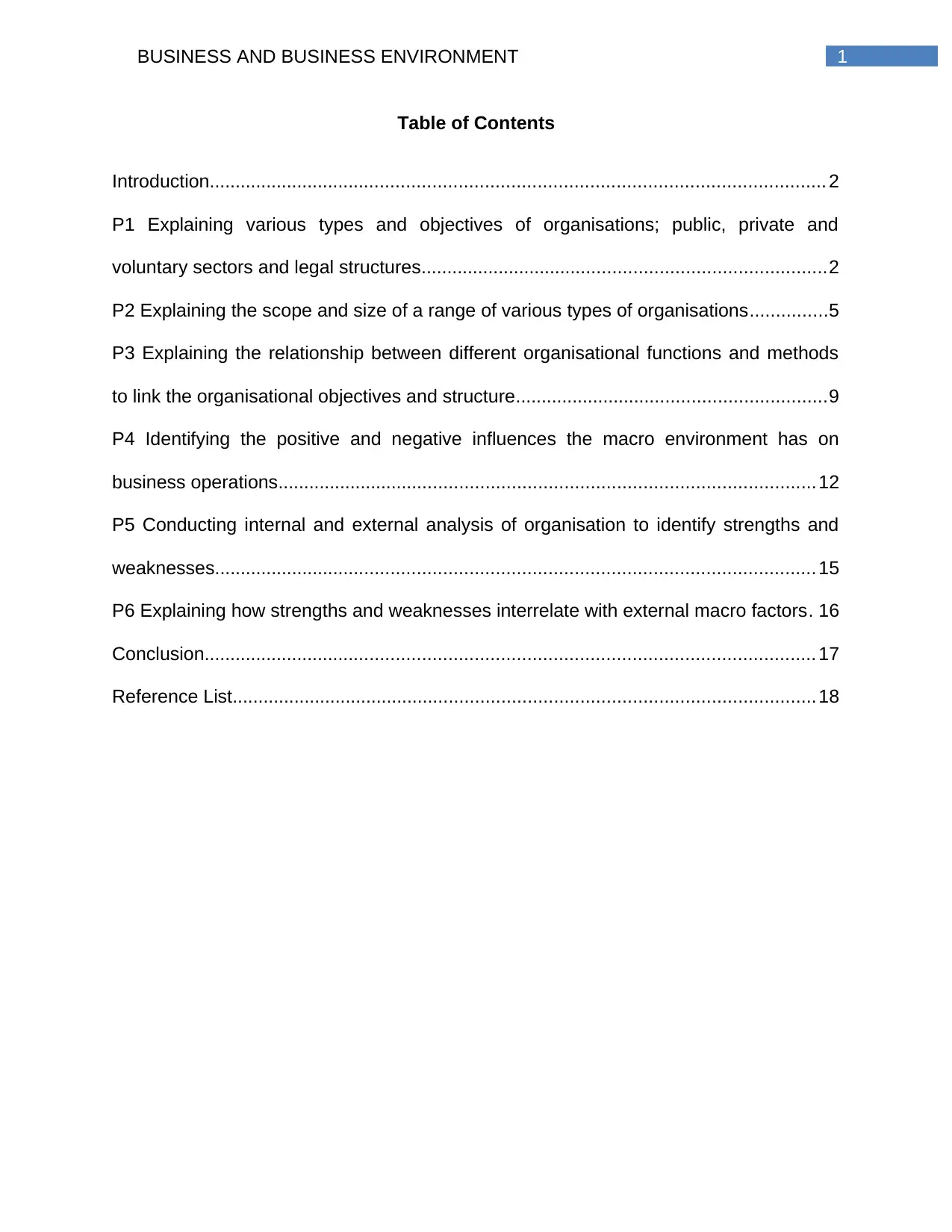
1BUSINESS AND BUSINESS ENVIRONMENT
Table of Contents
Introduction...................................................................................................................... 2
P1 Explaining various types and objectives of organisations; public, private and
voluntary sectors and legal structures..............................................................................2
P2 Explaining the scope and size of a range of various types of organisations...............5
P3 Explaining the relationship between different organisational functions and methods
to link the organisational objectives and structure............................................................9
P4 Identifying the positive and negative influences the macro environment has on
business operations....................................................................................................... 12
P5 Conducting internal and external analysis of organisation to identify strengths and
weaknesses................................................................................................................... 15
P6 Explaining how strengths and weaknesses interrelate with external macro factors. 16
Conclusion..................................................................................................................... 17
Reference List................................................................................................................ 18
Table of Contents
Introduction...................................................................................................................... 2
P1 Explaining various types and objectives of organisations; public, private and
voluntary sectors and legal structures..............................................................................2
P2 Explaining the scope and size of a range of various types of organisations...............5
P3 Explaining the relationship between different organisational functions and methods
to link the organisational objectives and structure............................................................9
P4 Identifying the positive and negative influences the macro environment has on
business operations....................................................................................................... 12
P5 Conducting internal and external analysis of organisation to identify strengths and
weaknesses................................................................................................................... 15
P6 Explaining how strengths and weaknesses interrelate with external macro factors. 16
Conclusion..................................................................................................................... 17
Reference List................................................................................................................ 18
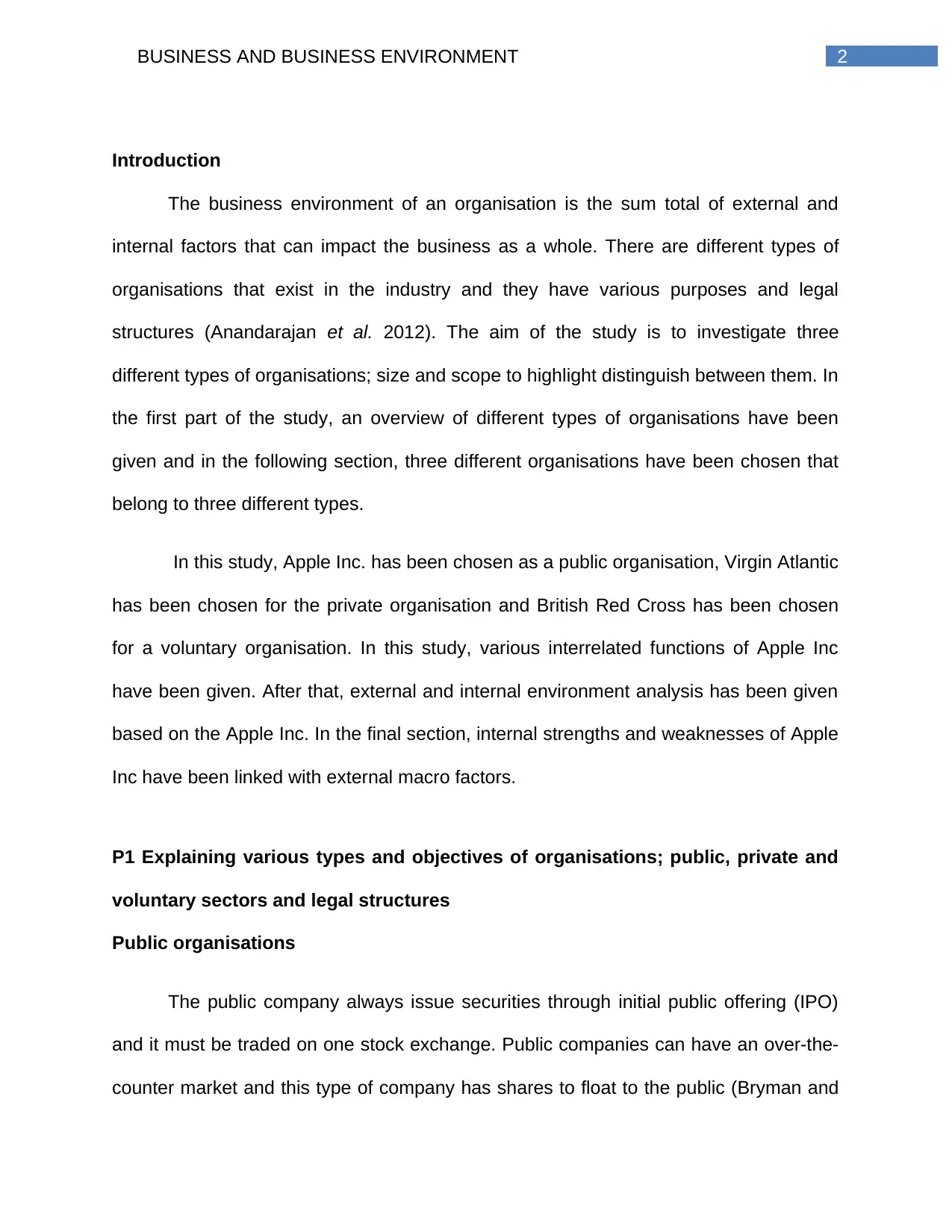
2BUSINESS AND BUSINESS ENVIRONMENT
Introduction
The business environment of an organisation is the sum total of external and
internal factors that can impact the business as a whole. There are different types of
organisations that exist in the industry and they have various purposes and legal
structures (Anandarajan et al. 2012). The aim of the study is to investigate three
different types of organisations; size and scope to highlight distinguish between them. In
the first part of the study, an overview of different types of organisations have been
given and in the following section, three different organisations have been chosen that
belong to three different types.
In this study, Apple Inc. has been chosen as a public organisation, Virgin Atlantic
has been chosen for the private organisation and British Red Cross has been chosen
for a voluntary organisation. In this study, various interrelated functions of Apple Inc
have been given. After that, external and internal environment analysis has been given
based on the Apple Inc. In the final section, internal strengths and weaknesses of Apple
Inc have been linked with external macro factors.
P1 Explaining various types and objectives of organisations; public, private and
voluntary sectors and legal structures
Public organisations
The public company always issue securities through initial public offering (IPO)
and it must be traded on one stock exchange. Public companies can have an over-the-
counter market and this type of company has shares to float to the public (Bryman and
Introduction
The business environment of an organisation is the sum total of external and
internal factors that can impact the business as a whole. There are different types of
organisations that exist in the industry and they have various purposes and legal
structures (Anandarajan et al. 2012). The aim of the study is to investigate three
different types of organisations; size and scope to highlight distinguish between them. In
the first part of the study, an overview of different types of organisations have been
given and in the following section, three different organisations have been chosen that
belong to three different types.
In this study, Apple Inc. has been chosen as a public organisation, Virgin Atlantic
has been chosen for the private organisation and British Red Cross has been chosen
for a voluntary organisation. In this study, various interrelated functions of Apple Inc
have been given. After that, external and internal environment analysis has been given
based on the Apple Inc. In the final section, internal strengths and weaknesses of Apple
Inc have been linked with external macro factors.
P1 Explaining various types and objectives of organisations; public, private and
voluntary sectors and legal structures
Public organisations
The public company always issue securities through initial public offering (IPO)
and it must be traded on one stock exchange. Public companies can have an over-the-
counter market and this type of company has shares to float to the public (Bryman and
⊘ This is a preview!⊘
Do you want full access?
Subscribe today to unlock all pages.

Trusted by 1+ million students worldwide
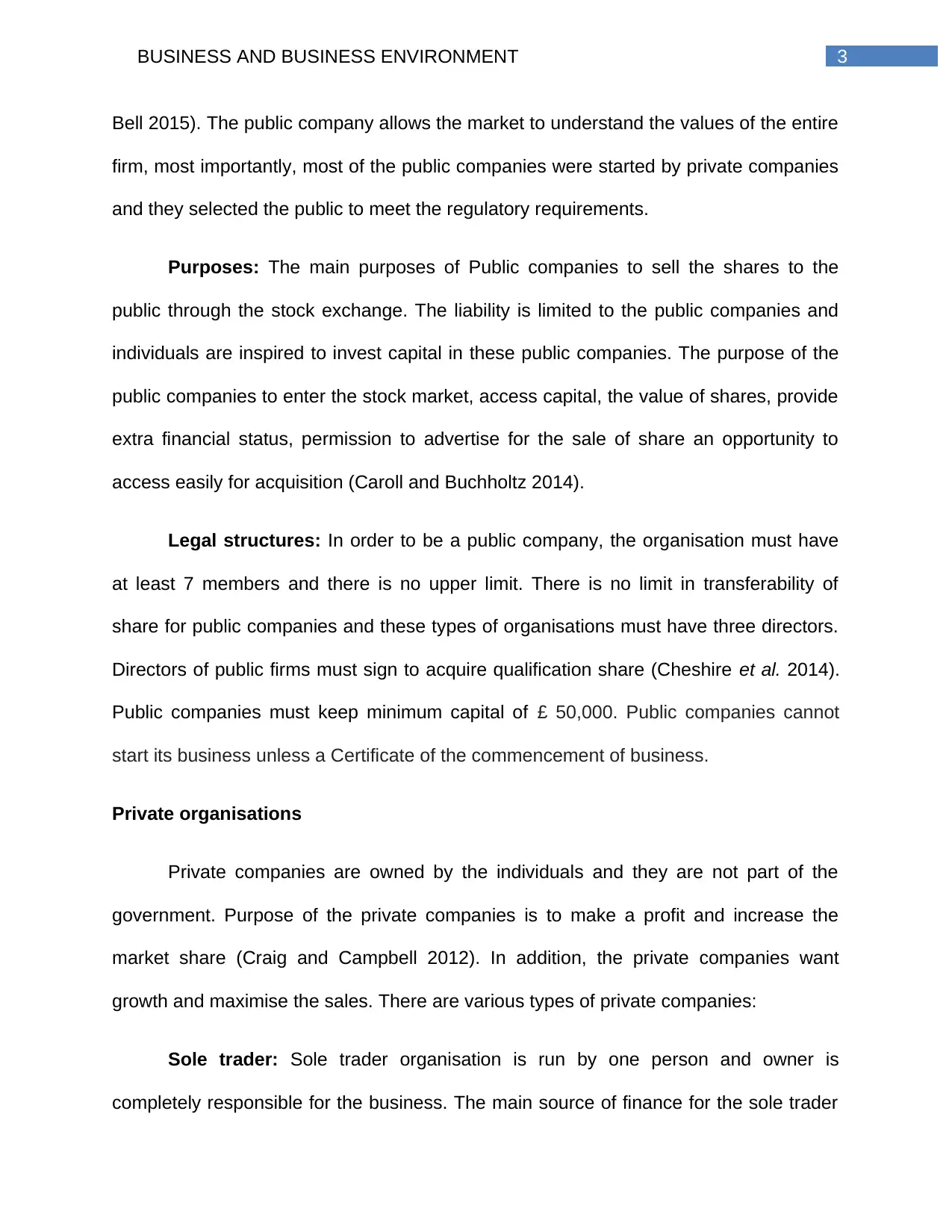
3BUSINESS AND BUSINESS ENVIRONMENT
Bell 2015). The public company allows the market to understand the values of the entire
firm, most importantly, most of the public companies were started by private companies
and they selected the public to meet the regulatory requirements.
Purposes: The main purposes of Public companies to sell the shares to the
public through the stock exchange. The liability is limited to the public companies and
individuals are inspired to invest capital in these public companies. The purpose of the
public companies to enter the stock market, access capital, the value of shares, provide
extra financial status, permission to advertise for the sale of share an opportunity to
access easily for acquisition (Caroll and Buchholtz 2014).
Legal structures: In order to be a public company, the organisation must have
at least 7 members and there is no upper limit. There is no limit in transferability of
share for public companies and these types of organisations must have three directors.
Directors of public firms must sign to acquire qualification share (Cheshire et al. 2014).
Public companies must keep minimum capital of £ 50,000. Public companies cannot
start its business unless a Certificate of the commencement of business.
Private organisations
Private companies are owned by the individuals and they are not part of the
government. Purpose of the private companies is to make a profit and increase the
market share (Craig and Campbell 2012). In addition, the private companies want
growth and maximise the sales. There are various types of private companies:
Sole trader: Sole trader organisation is run by one person and owner is
completely responsible for the business. The main source of finance for the sole trader
Bell 2015). The public company allows the market to understand the values of the entire
firm, most importantly, most of the public companies were started by private companies
and they selected the public to meet the regulatory requirements.
Purposes: The main purposes of Public companies to sell the shares to the
public through the stock exchange. The liability is limited to the public companies and
individuals are inspired to invest capital in these public companies. The purpose of the
public companies to enter the stock market, access capital, the value of shares, provide
extra financial status, permission to advertise for the sale of share an opportunity to
access easily for acquisition (Caroll and Buchholtz 2014).
Legal structures: In order to be a public company, the organisation must have
at least 7 members and there is no upper limit. There is no limit in transferability of
share for public companies and these types of organisations must have three directors.
Directors of public firms must sign to acquire qualification share (Cheshire et al. 2014).
Public companies must keep minimum capital of £ 50,000. Public companies cannot
start its business unless a Certificate of the commencement of business.
Private organisations
Private companies are owned by the individuals and they are not part of the
government. Purpose of the private companies is to make a profit and increase the
market share (Craig and Campbell 2012). In addition, the private companies want
growth and maximise the sales. There are various types of private companies:
Sole trader: Sole trader organisation is run by one person and owner is
completely responsible for the business. The main source of finance for the sole trader
Paraphrase This Document
Need a fresh take? Get an instant paraphrase of this document with our AI Paraphraser
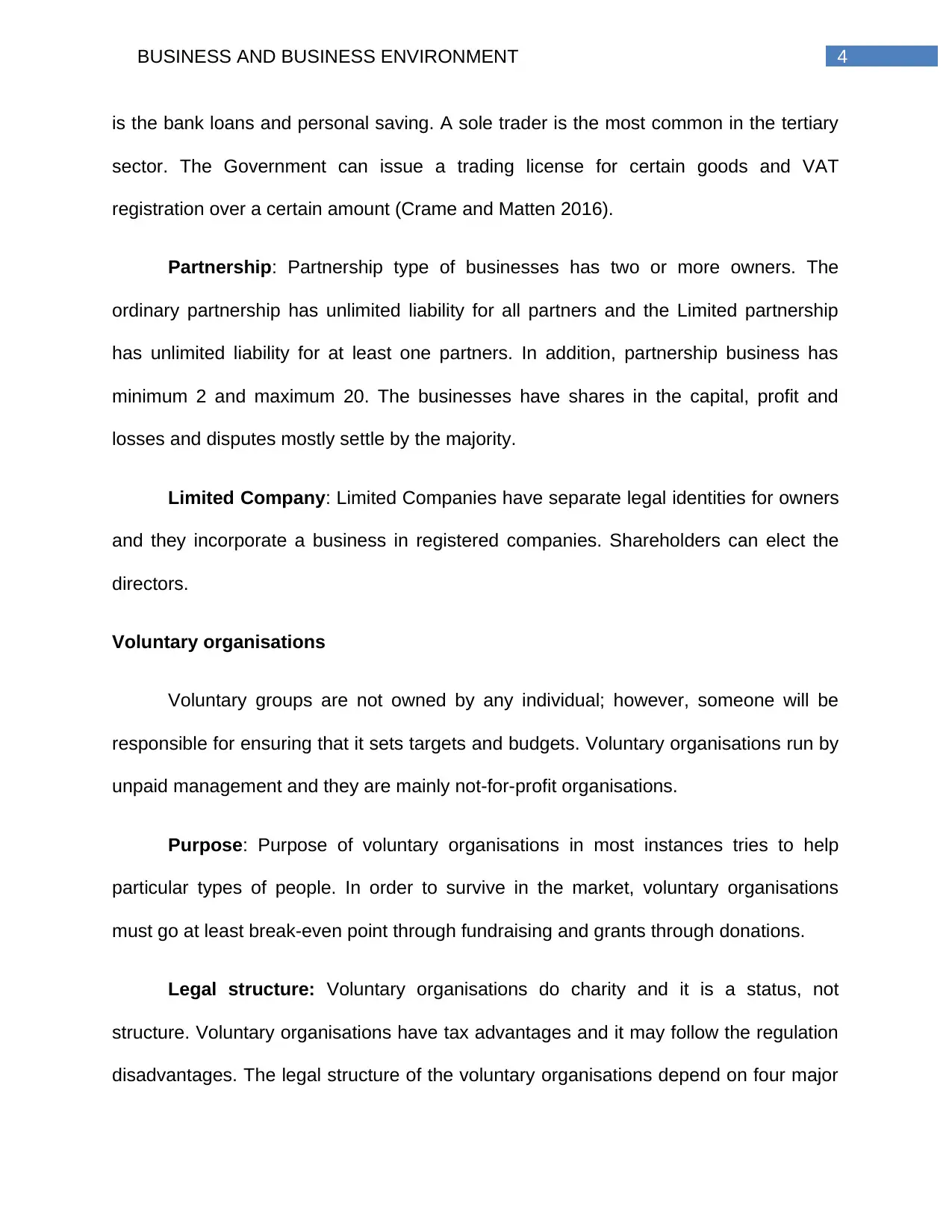
4BUSINESS AND BUSINESS ENVIRONMENT
is the bank loans and personal saving. A sole trader is the most common in the tertiary
sector. The Government can issue a trading license for certain goods and VAT
registration over a certain amount (Crame and Matten 2016).
Partnership: Partnership type of businesses has two or more owners. The
ordinary partnership has unlimited liability for all partners and the Limited partnership
has unlimited liability for at least one partners. In addition, partnership business has
minimum 2 and maximum 20. The businesses have shares in the capital, profit and
losses and disputes mostly settle by the majority.
Limited Company: Limited Companies have separate legal identities for owners
and they incorporate a business in registered companies. Shareholders can elect the
directors.
Voluntary organisations
Voluntary groups are not owned by any individual; however, someone will be
responsible for ensuring that it sets targets and budgets. Voluntary organisations run by
unpaid management and they are mainly not-for-profit organisations.
Purpose: Purpose of voluntary organisations in most instances tries to help
particular types of people. In order to survive in the market, voluntary organisations
must go at least break-even point through fundraising and grants through donations.
Legal structure: Voluntary organisations do charity and it is a status, not
structure. Voluntary organisations have tax advantages and it may follow the regulation
disadvantages. The legal structure of the voluntary organisations depend on four major
is the bank loans and personal saving. A sole trader is the most common in the tertiary
sector. The Government can issue a trading license for certain goods and VAT
registration over a certain amount (Crame and Matten 2016).
Partnership: Partnership type of businesses has two or more owners. The
ordinary partnership has unlimited liability for all partners and the Limited partnership
has unlimited liability for at least one partners. In addition, partnership business has
minimum 2 and maximum 20. The businesses have shares in the capital, profit and
losses and disputes mostly settle by the majority.
Limited Company: Limited Companies have separate legal identities for owners
and they incorporate a business in registered companies. Shareholders can elect the
directors.
Voluntary organisations
Voluntary groups are not owned by any individual; however, someone will be
responsible for ensuring that it sets targets and budgets. Voluntary organisations run by
unpaid management and they are mainly not-for-profit organisations.
Purpose: Purpose of voluntary organisations in most instances tries to help
particular types of people. In order to survive in the market, voluntary organisations
must go at least break-even point through fundraising and grants through donations.
Legal structure: Voluntary organisations do charity and it is a status, not
structure. Voluntary organisations have tax advantages and it may follow the regulation
disadvantages. The legal structure of the voluntary organisations depend on four major
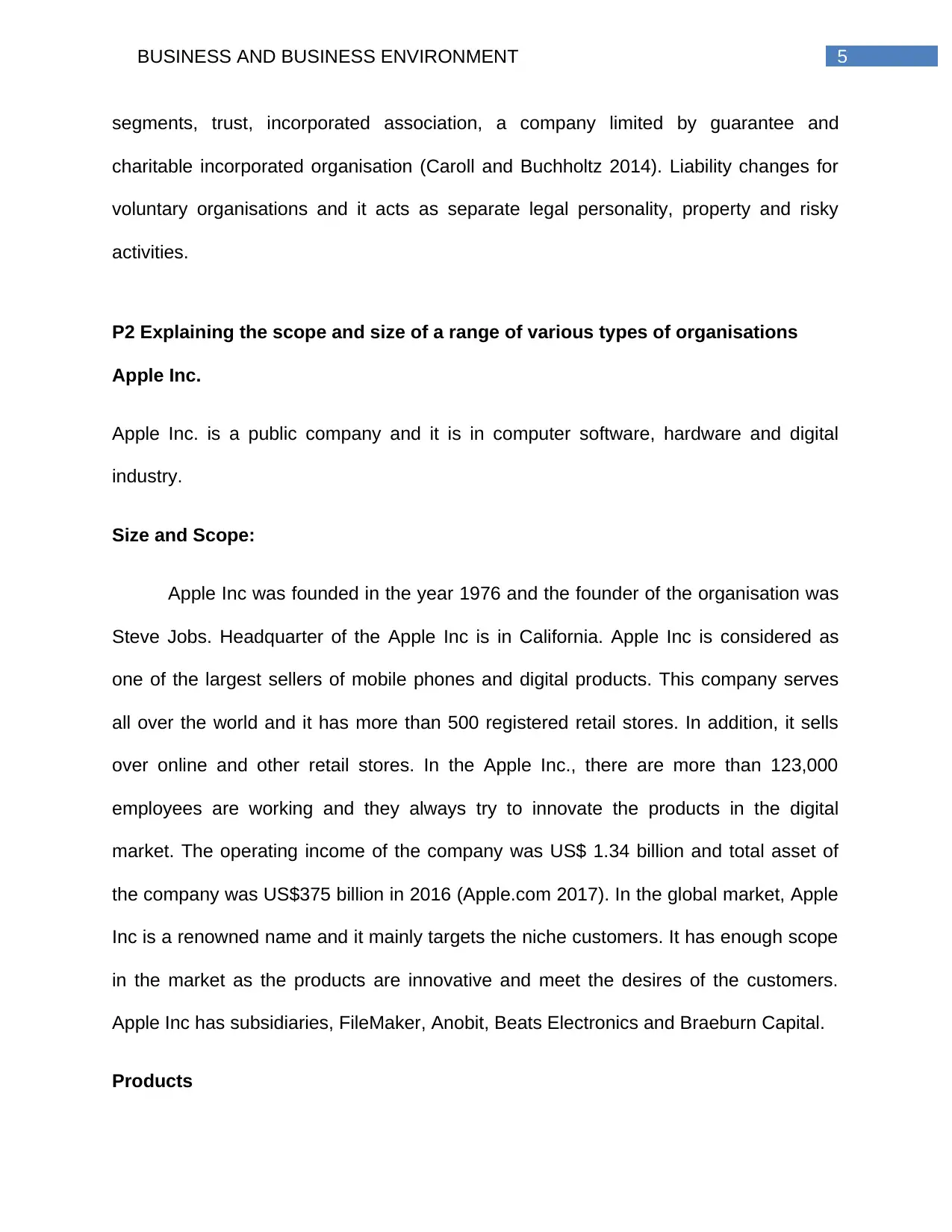
5BUSINESS AND BUSINESS ENVIRONMENT
segments, trust, incorporated association, a company limited by guarantee and
charitable incorporated organisation (Caroll and Buchholtz 2014). Liability changes for
voluntary organisations and it acts as separate legal personality, property and risky
activities.
P2 Explaining the scope and size of a range of various types of organisations
Apple Inc.
Apple Inc. is a public company and it is in computer software, hardware and digital
industry.
Size and Scope:
Apple Inc was founded in the year 1976 and the founder of the organisation was
Steve Jobs. Headquarter of the Apple Inc is in California. Apple Inc is considered as
one of the largest sellers of mobile phones and digital products. This company serves
all over the world and it has more than 500 registered retail stores. In addition, it sells
over online and other retail stores. In the Apple Inc., there are more than 123,000
employees are working and they always try to innovate the products in the digital
market. The operating income of the company was US$ 1.34 billion and total asset of
the company was US$375 billion in 2016 (Apple.com 2017). In the global market, Apple
Inc is a renowned name and it mainly targets the niche customers. It has enough scope
in the market as the products are innovative and meet the desires of the customers.
Apple Inc has subsidiaries, FileMaker, Anobit, Beats Electronics and Braeburn Capital.
Products
segments, trust, incorporated association, a company limited by guarantee and
charitable incorporated organisation (Caroll and Buchholtz 2014). Liability changes for
voluntary organisations and it acts as separate legal personality, property and risky
activities.
P2 Explaining the scope and size of a range of various types of organisations
Apple Inc.
Apple Inc. is a public company and it is in computer software, hardware and digital
industry.
Size and Scope:
Apple Inc was founded in the year 1976 and the founder of the organisation was
Steve Jobs. Headquarter of the Apple Inc is in California. Apple Inc is considered as
one of the largest sellers of mobile phones and digital products. This company serves
all over the world and it has more than 500 registered retail stores. In addition, it sells
over online and other retail stores. In the Apple Inc., there are more than 123,000
employees are working and they always try to innovate the products in the digital
market. The operating income of the company was US$ 1.34 billion and total asset of
the company was US$375 billion in 2016 (Apple.com 2017). In the global market, Apple
Inc is a renowned name and it mainly targets the niche customers. It has enough scope
in the market as the products are innovative and meet the desires of the customers.
Apple Inc has subsidiaries, FileMaker, Anobit, Beats Electronics and Braeburn Capital.
Products
⊘ This is a preview!⊘
Do you want full access?
Subscribe today to unlock all pages.

Trusted by 1+ million students worldwide
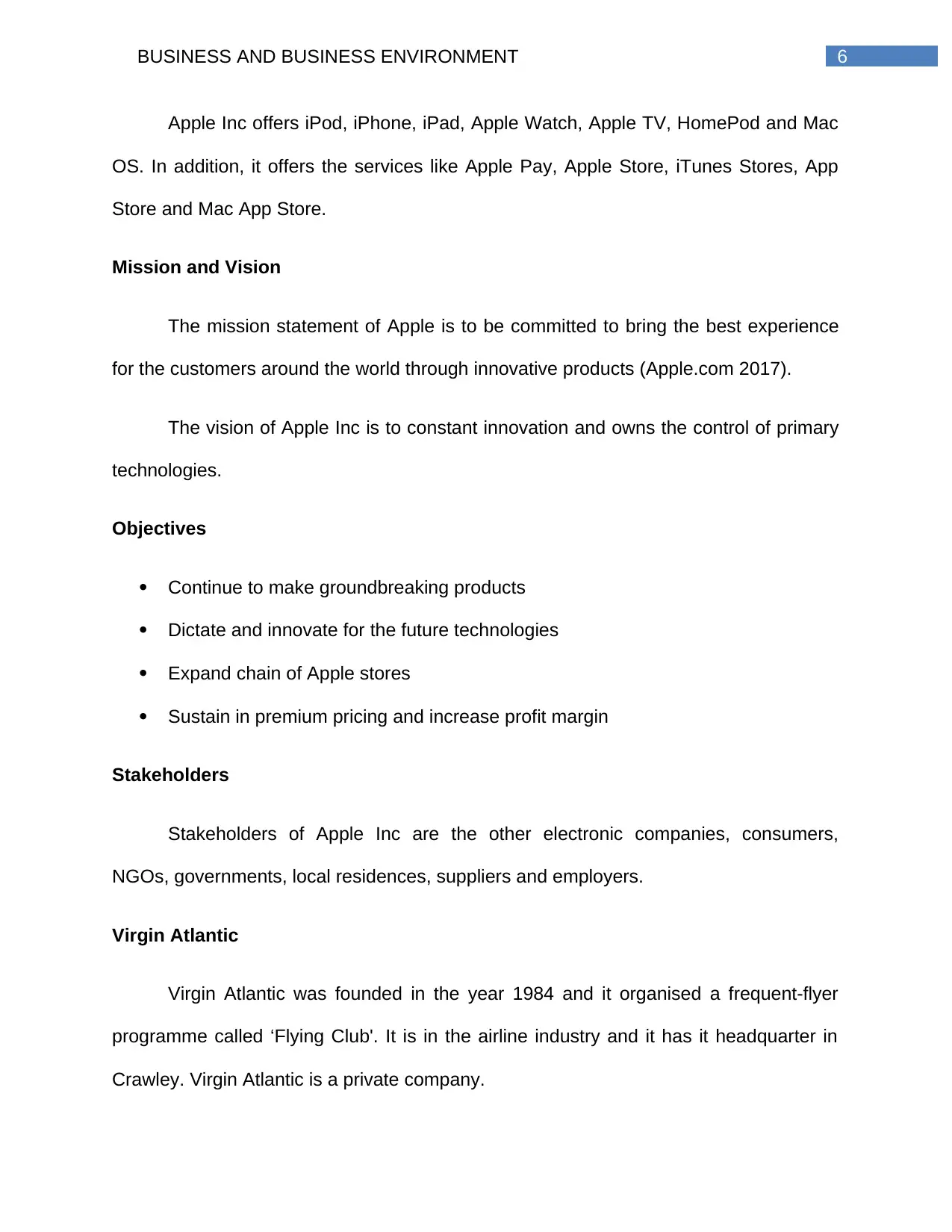
6BUSINESS AND BUSINESS ENVIRONMENT
Apple Inc offers iPod, iPhone, iPad, Apple Watch, Apple TV, HomePod and Mac
OS. In addition, it offers the services like Apple Pay, Apple Store, iTunes Stores, App
Store and Mac App Store.
Mission and Vision
The mission statement of Apple is to be committed to bring the best experience
for the customers around the world through innovative products (Apple.com 2017).
The vision of Apple Inc is to constant innovation and owns the control of primary
technologies.
Objectives
Continue to make groundbreaking products
Dictate and innovate for the future technologies
Expand chain of Apple stores
Sustain in premium pricing and increase profit margin
Stakeholders
Stakeholders of Apple Inc are the other electronic companies, consumers,
NGOs, governments, local residences, suppliers and employers.
Virgin Atlantic
Virgin Atlantic was founded in the year 1984 and it organised a frequent-flyer
programme called ‘Flying Club'. It is in the airline industry and it has it headquarter in
Crawley. Virgin Atlantic is a private company.
Apple Inc offers iPod, iPhone, iPad, Apple Watch, Apple TV, HomePod and Mac
OS. In addition, it offers the services like Apple Pay, Apple Store, iTunes Stores, App
Store and Mac App Store.
Mission and Vision
The mission statement of Apple is to be committed to bring the best experience
for the customers around the world through innovative products (Apple.com 2017).
The vision of Apple Inc is to constant innovation and owns the control of primary
technologies.
Objectives
Continue to make groundbreaking products
Dictate and innovate for the future technologies
Expand chain of Apple stores
Sustain in premium pricing and increase profit margin
Stakeholders
Stakeholders of Apple Inc are the other electronic companies, consumers,
NGOs, governments, local residences, suppliers and employers.
Virgin Atlantic
Virgin Atlantic was founded in the year 1984 and it organised a frequent-flyer
programme called ‘Flying Club'. It is in the airline industry and it has it headquarter in
Crawley. Virgin Atlantic is a private company.
Paraphrase This Document
Need a fresh take? Get an instant paraphrase of this document with our AI Paraphraser
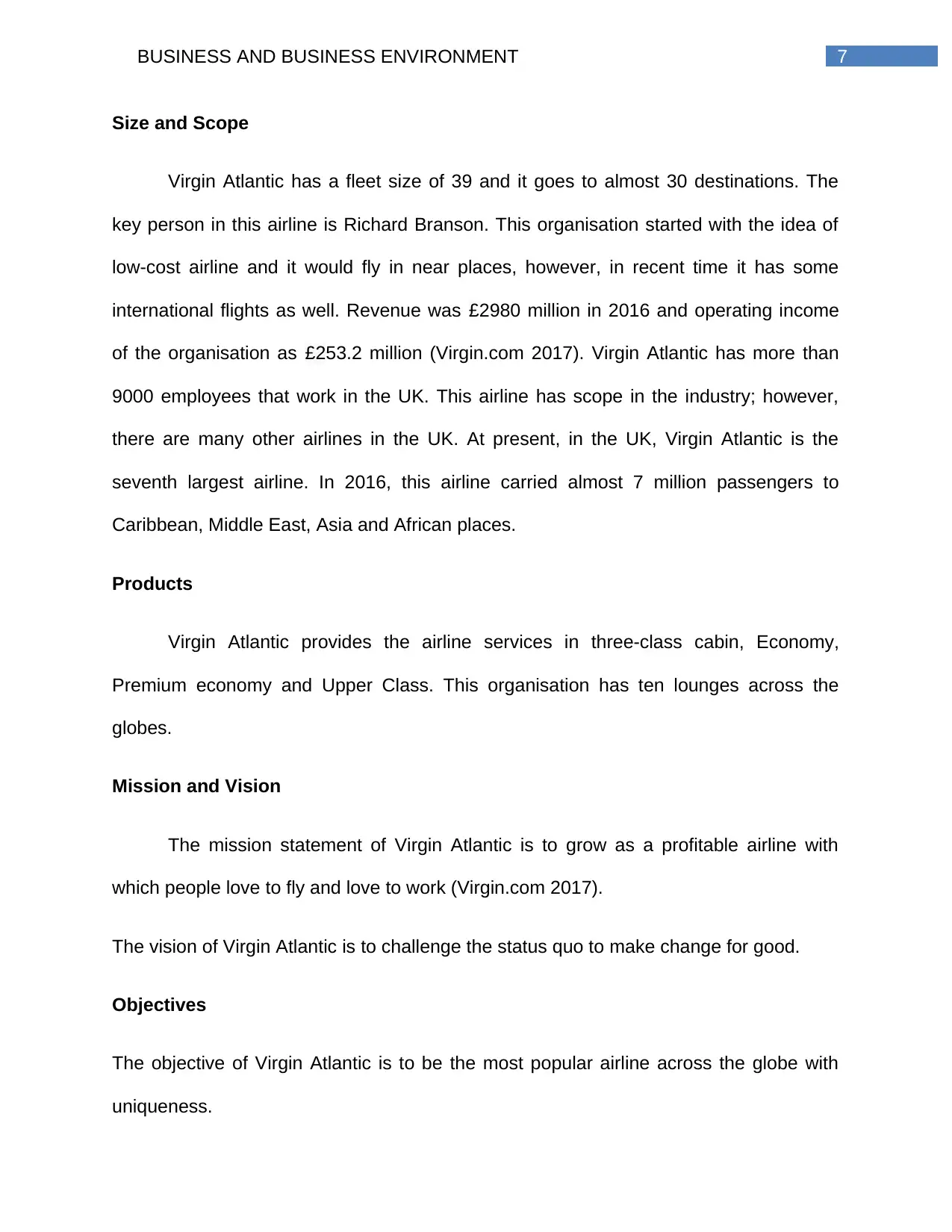
7BUSINESS AND BUSINESS ENVIRONMENT
Size and Scope
Virgin Atlantic has a fleet size of 39 and it goes to almost 30 destinations. The
key person in this airline is Richard Branson. This organisation started with the idea of
low-cost airline and it would fly in near places, however, in recent time it has some
international flights as well. Revenue was £2980 million in 2016 and operating income
of the organisation as £253.2 million (Virgin.com 2017). Virgin Atlantic has more than
9000 employees that work in the UK. This airline has scope in the industry; however,
there are many other airlines in the UK. At present, in the UK, Virgin Atlantic is the
seventh largest airline. In 2016, this airline carried almost 7 million passengers to
Caribbean, Middle East, Asia and African places.
Products
Virgin Atlantic provides the airline services in three-class cabin, Economy,
Premium economy and Upper Class. This organisation has ten lounges across the
globes.
Mission and Vision
The mission statement of Virgin Atlantic is to grow as a profitable airline with
which people love to fly and love to work (Virgin.com 2017).
The vision of Virgin Atlantic is to challenge the status quo to make change for good.
Objectives
The objective of Virgin Atlantic is to be the most popular airline across the globe with
uniqueness.
Size and Scope
Virgin Atlantic has a fleet size of 39 and it goes to almost 30 destinations. The
key person in this airline is Richard Branson. This organisation started with the idea of
low-cost airline and it would fly in near places, however, in recent time it has some
international flights as well. Revenue was £2980 million in 2016 and operating income
of the organisation as £253.2 million (Virgin.com 2017). Virgin Atlantic has more than
9000 employees that work in the UK. This airline has scope in the industry; however,
there are many other airlines in the UK. At present, in the UK, Virgin Atlantic is the
seventh largest airline. In 2016, this airline carried almost 7 million passengers to
Caribbean, Middle East, Asia and African places.
Products
Virgin Atlantic provides the airline services in three-class cabin, Economy,
Premium economy and Upper Class. This organisation has ten lounges across the
globes.
Mission and Vision
The mission statement of Virgin Atlantic is to grow as a profitable airline with
which people love to fly and love to work (Virgin.com 2017).
The vision of Virgin Atlantic is to challenge the status quo to make change for good.
Objectives
The objective of Virgin Atlantic is to be the most popular airline across the globe with
uniqueness.
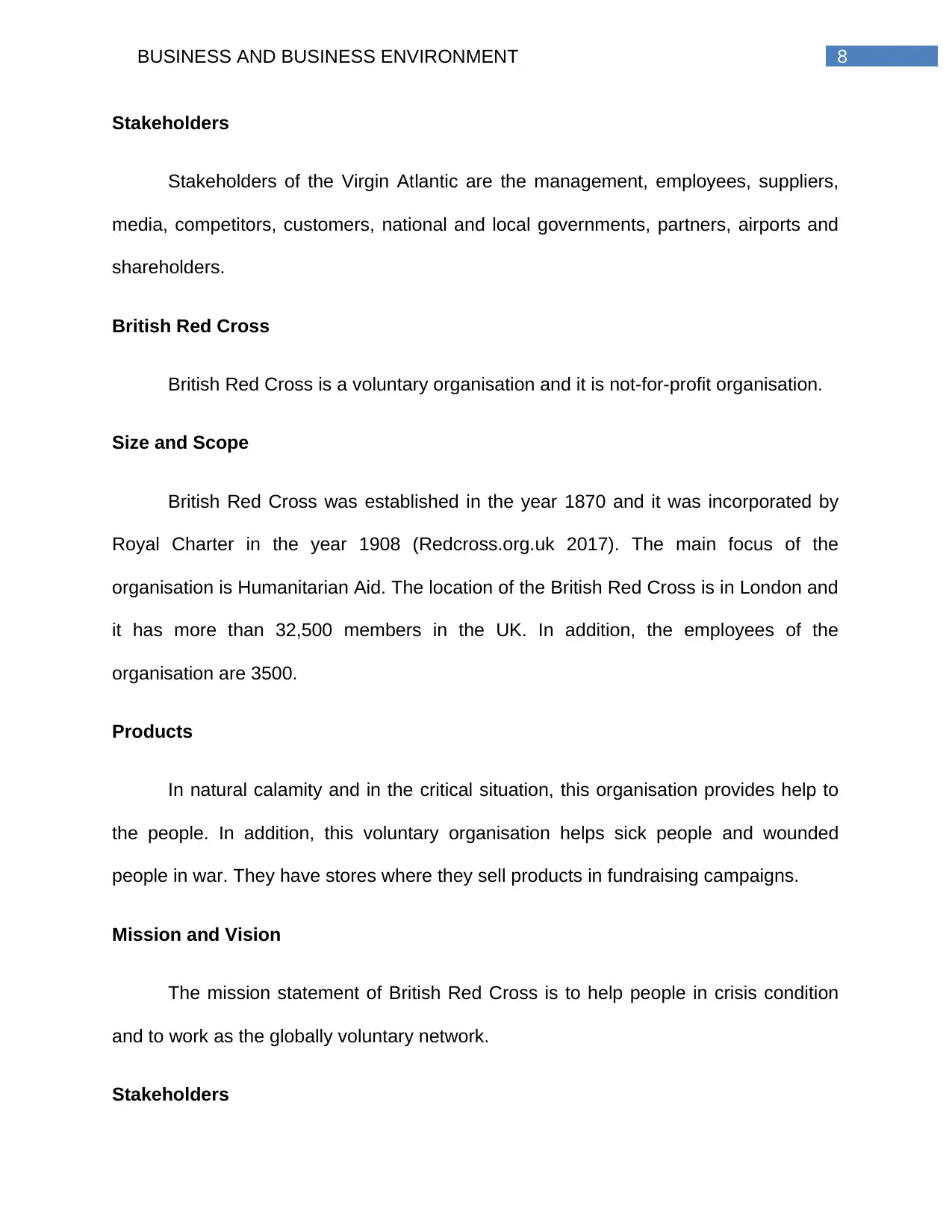
8BUSINESS AND BUSINESS ENVIRONMENT
Stakeholders
Stakeholders of the Virgin Atlantic are the management, employees, suppliers,
media, competitors, customers, national and local governments, partners, airports and
shareholders.
British Red Cross
British Red Cross is a voluntary organisation and it is not-for-profit organisation.
Size and Scope
British Red Cross was established in the year 1870 and it was incorporated by
Royal Charter in the year 1908 (Redcross.org.uk 2017). The main focus of the
organisation is Humanitarian Aid. The location of the British Red Cross is in London and
it has more than 32,500 members in the UK. In addition, the employees of the
organisation are 3500.
Products
In natural calamity and in the critical situation, this organisation provides help to
the people. In addition, this voluntary organisation helps sick people and wounded
people in war. They have stores where they sell products in fundraising campaigns.
Mission and Vision
The mission statement of British Red Cross is to help people in crisis condition
and to work as the globally voluntary network.
Stakeholders
Stakeholders
Stakeholders of the Virgin Atlantic are the management, employees, suppliers,
media, competitors, customers, national and local governments, partners, airports and
shareholders.
British Red Cross
British Red Cross is a voluntary organisation and it is not-for-profit organisation.
Size and Scope
British Red Cross was established in the year 1870 and it was incorporated by
Royal Charter in the year 1908 (Redcross.org.uk 2017). The main focus of the
organisation is Humanitarian Aid. The location of the British Red Cross is in London and
it has more than 32,500 members in the UK. In addition, the employees of the
organisation are 3500.
Products
In natural calamity and in the critical situation, this organisation provides help to
the people. In addition, this voluntary organisation helps sick people and wounded
people in war. They have stores where they sell products in fundraising campaigns.
Mission and Vision
The mission statement of British Red Cross is to help people in crisis condition
and to work as the globally voluntary network.
Stakeholders
⊘ This is a preview!⊘
Do you want full access?
Subscribe today to unlock all pages.

Trusted by 1+ million students worldwide
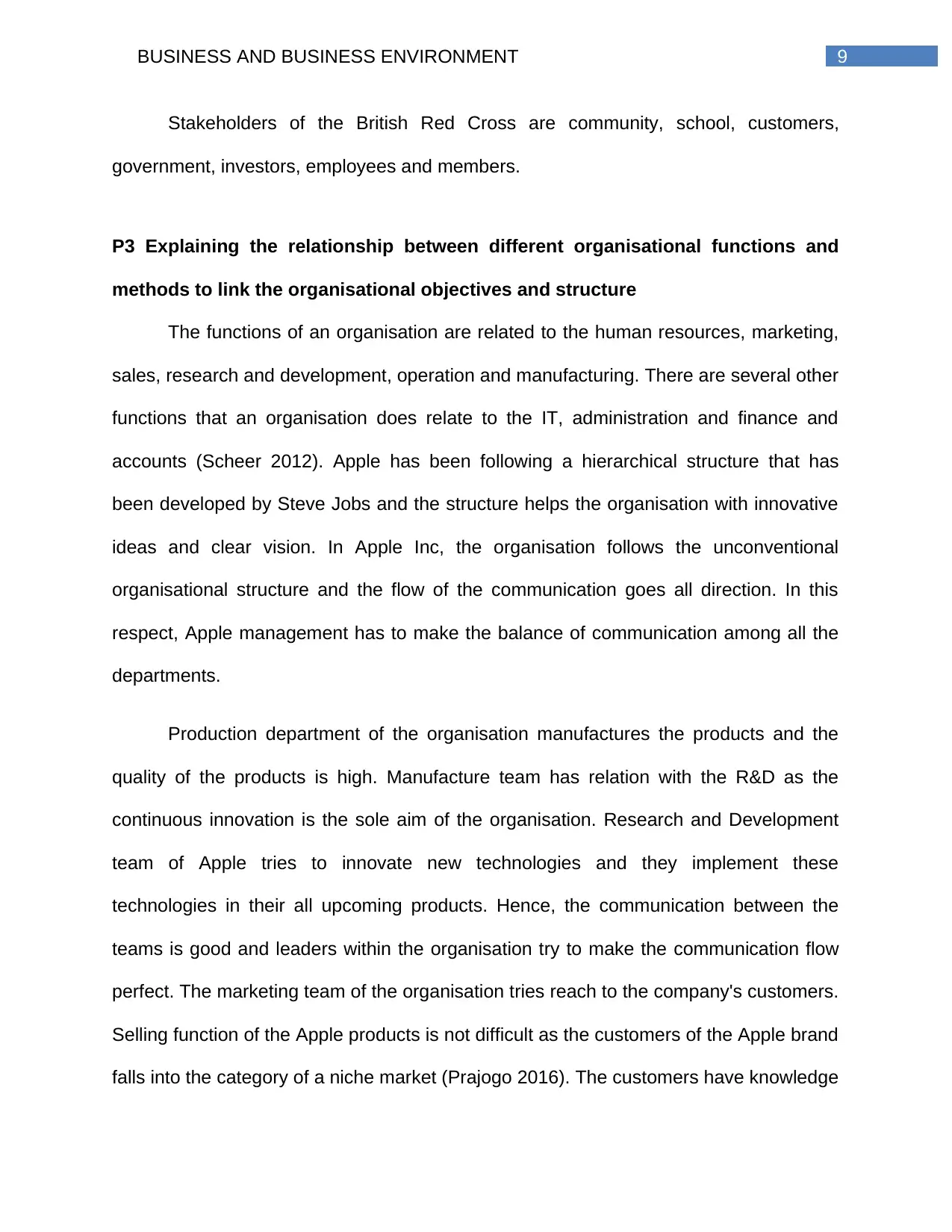
9BUSINESS AND BUSINESS ENVIRONMENT
Stakeholders of the British Red Cross are community, school, customers,
government, investors, employees and members.
P3 Explaining the relationship between different organisational functions and
methods to link the organisational objectives and structure
The functions of an organisation are related to the human resources, marketing,
sales, research and development, operation and manufacturing. There are several other
functions that an organisation does relate to the IT, administration and finance and
accounts (Scheer 2012). Apple has been following a hierarchical structure that has
been developed by Steve Jobs and the structure helps the organisation with innovative
ideas and clear vision. In Apple Inc, the organisation follows the unconventional
organisational structure and the flow of the communication goes all direction. In this
respect, Apple management has to make the balance of communication among all the
departments.
Production department of the organisation manufactures the products and the
quality of the products is high. Manufacture team has relation with the R&D as the
continuous innovation is the sole aim of the organisation. Research and Development
team of Apple tries to innovate new technologies and they implement these
technologies in their all upcoming products. Hence, the communication between the
teams is good and leaders within the organisation try to make the communication flow
perfect. The marketing team of the organisation tries reach to the company's customers.
Selling function of the Apple products is not difficult as the customers of the Apple brand
falls into the category of a niche market (Prajogo 2016). The customers have knowledge
Stakeholders of the British Red Cross are community, school, customers,
government, investors, employees and members.
P3 Explaining the relationship between different organisational functions and
methods to link the organisational objectives and structure
The functions of an organisation are related to the human resources, marketing,
sales, research and development, operation and manufacturing. There are several other
functions that an organisation does relate to the IT, administration and finance and
accounts (Scheer 2012). Apple has been following a hierarchical structure that has
been developed by Steve Jobs and the structure helps the organisation with innovative
ideas and clear vision. In Apple Inc, the organisation follows the unconventional
organisational structure and the flow of the communication goes all direction. In this
respect, Apple management has to make the balance of communication among all the
departments.
Production department of the organisation manufactures the products and the
quality of the products is high. Manufacture team has relation with the R&D as the
continuous innovation is the sole aim of the organisation. Research and Development
team of Apple tries to innovate new technologies and they implement these
technologies in their all upcoming products. Hence, the communication between the
teams is good and leaders within the organisation try to make the communication flow
perfect. The marketing team of the organisation tries reach to the company's customers.
Selling function of the Apple products is not difficult as the customers of the Apple brand
falls into the category of a niche market (Prajogo 2016). The customers have knowledge
Paraphrase This Document
Need a fresh take? Get an instant paraphrase of this document with our AI Paraphraser
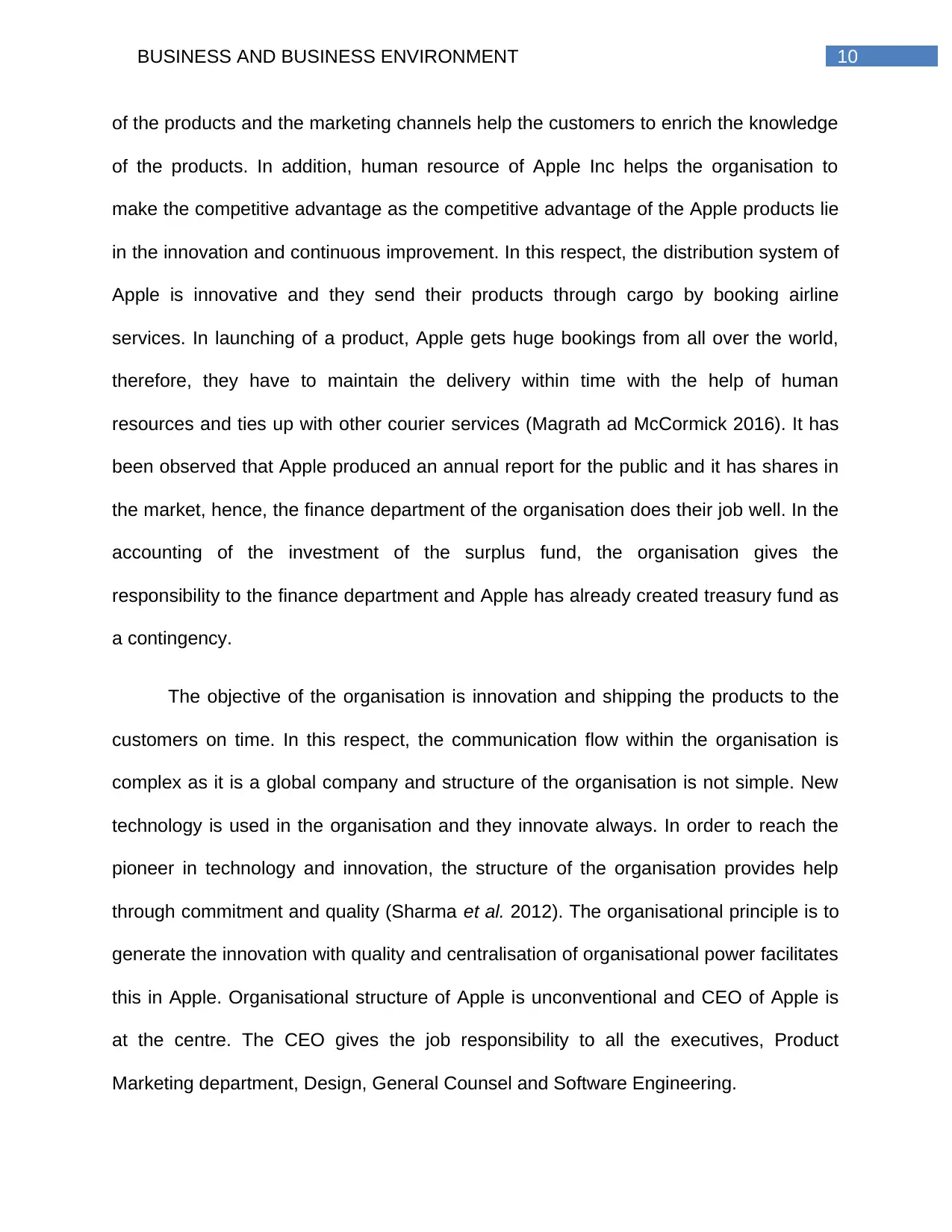
10BUSINESS AND BUSINESS ENVIRONMENT
of the products and the marketing channels help the customers to enrich the knowledge
of the products. In addition, human resource of Apple Inc helps the organisation to
make the competitive advantage as the competitive advantage of the Apple products lie
in the innovation and continuous improvement. In this respect, the distribution system of
Apple is innovative and they send their products through cargo by booking airline
services. In launching of a product, Apple gets huge bookings from all over the world,
therefore, they have to maintain the delivery within time with the help of human
resources and ties up with other courier services (Magrath ad McCormick 2016). It has
been observed that Apple produced an annual report for the public and it has shares in
the market, hence, the finance department of the organisation does their job well. In the
accounting of the investment of the surplus fund, the organisation gives the
responsibility to the finance department and Apple has already created treasury fund as
a contingency.
The objective of the organisation is innovation and shipping the products to the
customers on time. In this respect, the communication flow within the organisation is
complex as it is a global company and structure of the organisation is not simple. New
technology is used in the organisation and they innovate always. In order to reach the
pioneer in technology and innovation, the structure of the organisation provides help
through commitment and quality (Sharma et al. 2012). The organisational principle is to
generate the innovation with quality and centralisation of organisational power facilitates
this in Apple. Organisational structure of Apple is unconventional and CEO of Apple is
at the centre. The CEO gives the job responsibility to all the executives, Product
Marketing department, Design, General Counsel and Software Engineering.
of the products and the marketing channels help the customers to enrich the knowledge
of the products. In addition, human resource of Apple Inc helps the organisation to
make the competitive advantage as the competitive advantage of the Apple products lie
in the innovation and continuous improvement. In this respect, the distribution system of
Apple is innovative and they send their products through cargo by booking airline
services. In launching of a product, Apple gets huge bookings from all over the world,
therefore, they have to maintain the delivery within time with the help of human
resources and ties up with other courier services (Magrath ad McCormick 2016). It has
been observed that Apple produced an annual report for the public and it has shares in
the market, hence, the finance department of the organisation does their job well. In the
accounting of the investment of the surplus fund, the organisation gives the
responsibility to the finance department and Apple has already created treasury fund as
a contingency.
The objective of the organisation is innovation and shipping the products to the
customers on time. In this respect, the communication flow within the organisation is
complex as it is a global company and structure of the organisation is not simple. New
technology is used in the organisation and they innovate always. In order to reach the
pioneer in technology and innovation, the structure of the organisation provides help
through commitment and quality (Sharma et al. 2012). The organisational principle is to
generate the innovation with quality and centralisation of organisational power facilitates
this in Apple. Organisational structure of Apple is unconventional and CEO of Apple is
at the centre. The CEO gives the job responsibility to all the executives, Product
Marketing department, Design, General Counsel and Software Engineering.
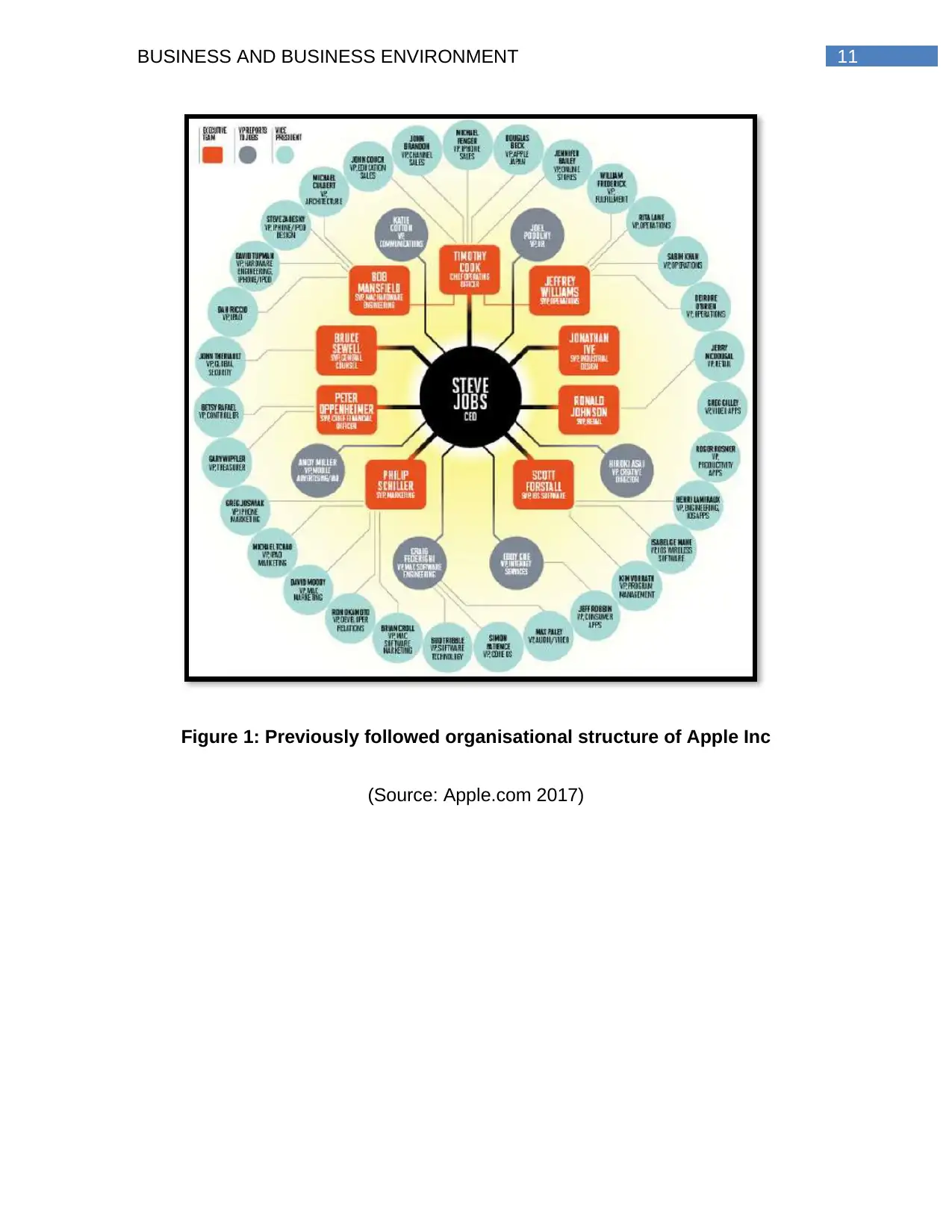
11BUSINESS AND BUSINESS ENVIRONMENT
Figure 1: Previously followed organisational structure of Apple Inc
(Source: Apple.com 2017)
Figure 1: Previously followed organisational structure of Apple Inc
(Source: Apple.com 2017)
⊘ This is a preview!⊘
Do you want full access?
Subscribe today to unlock all pages.

Trusted by 1+ million students worldwide
1 out of 22
Related Documents
Your All-in-One AI-Powered Toolkit for Academic Success.
+13062052269
info@desklib.com
Available 24*7 on WhatsApp / Email
![[object Object]](/_next/static/media/star-bottom.7253800d.svg)
Unlock your academic potential
Copyright © 2020–2025 A2Z Services. All Rights Reserved. Developed and managed by ZUCOL.





